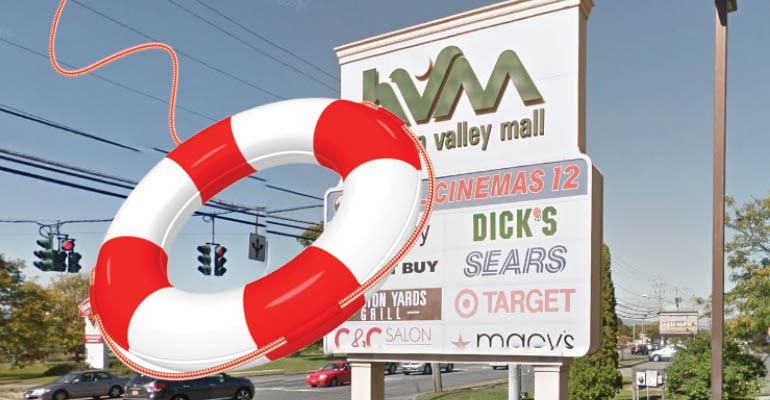(Bloomberg)—The Hudson Valley Mall, nestled on a picturesque hilltop in Kingston, N.Y., looks like a pleasant place to spend an afternoon—from the outside. Inside, it just feels empty.
Until recently, the 765,000-square-foot structure was best known for its infamous past as the scene of a Columbine-inspired shooting in 2005, when a local gunman fired off 60 rounds from an assault rifle. JC Penney and Co. shuttered its store in 2015, and Macy's Inc. closed its doors last year. Smaller retailers followed, and as of Feb. 2016, 33 percent of the mall space—not including anchor stores—sat vacant, according to Bloomberg data.
The property, which was appraised at a value of $87 million in 2010, sold for $9.4 million in January to Hull Property Group, an Augusta, Ga.-based operator that has spent the last decade bringing distressed malls back to life. The company, which owns 29 malls across the U.S., sticks to a proven script that includes negotiating tax incentives with local governments, demolishing excess space, and reversing public perceptions that the property is struggling.
“If the grim reaper hasn't come yet, then he’s circling pretty good,” said Hull, describing the properties he targets.
Buying malls on the cheap leaves Hull with plenty of money for aesthetic improvements, such as raising the ceilings and removing kiosks in a bid to create long sight lines and a sense of open space. Other tactics include hanging sheetrock over empty storefronts and ending leases with down-market tenants in hopes of attracting more upscale retailers.
Hull is one of a small crowd of operators bucking the conventional wisdom that there are simply too many malls and that only those catering to wealthy shoppers will survive the death of legacy retailers. While operating strategies vary, most are shopping for older malls in places with no other enclosed shopping center within 50 to 100 miles.
Such older properties have some inherent advantages. Many were built as the surrounding community was sprouting, so the original developers had their pick of the best locations. Despite the rise of e-commerce, people still come to malls to participate in the social aspect of shopping—especially in suburban or exurban places with few large gathering places.
Andy Weiner, president of Houston-based RockStep Capital, paid $28 million when he bought the Bonita Lakes Mall in Meridian, Miss., in May, a fraction of the $85 million it cost to build when it was completed in 1997. Weiner, who has acquired about 6 million square feet of mall space over the last two decades, says his mission is "to make small town America better." His company is now working to revive the facility by upgrading the movie theater and bringing in the nontraditional tenants—a community college, say, or a government office—that mall operators are increasingly courting in hopes of increasing foot traffic. Over the longer term, Weiner is betting that he can make money by passing on discounted rents to retail tenants.
“If you own it at 20 cents on the dollar, you can provide tenants with very profitable stores, because you can give them cheap rents,” he explained.
Time Equities Inc., a New York-based real estate firm, has long invested in strip malls, said Ami Ziff, director of retail at the company. Over the past five years, the rise of the dead-mall narrative led the company to start hunting for contrarian opportunities. It bought its first enclosed mall in 2010 and its fifth in Zanesville, Ohio, earlier this year. By the end of 2017, Ziff said, the company would like to own 10.
Like other operators buying on the cheap, Ziff's team makes small improvements—replacing old signage, adding murals, and upgrading the nursing stations in the women's bathrooms—and bets that a mall can still be a shopping and entertainment hub.
“We want to be in markets where the mall is still one of the more interesting things to do on the weekend,” Ziff said.
Some malls struggle because they simply can’t access credit, said George Good, executive vice president in CBRE Group's National Retail Investment Group. As department stores close and large mall operators retrench around their best assets, many lenders have decided to stop financing lower-quality properties. In many cases, owners that can’t get a new loan will look to sell at a discount, or let the mall go into foreclosure.
“It’s almost a self-fulfilling prophecy,” said Good.
Not every struggling mall is a good candidate for a refresh. In bigger markets with stiffer retail competition, developers have considered more radical strategies for failed malls, such as turning them into office buildings, medical centers, and hotels with mixed results. The City of Charlotte, N.C., bought a closed mall in 2012 and demolished it, kicking around plans to build a mixed-use development, or perhaps a Major League Soccer stadium on the site. Nothing has come to fruition, though, and last year the city issued a call for proposals on a listing service that specializes in such distressed properties as landfills and abandoned chemical plants.
Still, the vicious nature of the retail business makes plenty of opportunities for investors.“We think there are somewhere between 100 and 200 malls out there that fit the general criteria” for a rehab, said Chris Maguire, chief executive officer at Cypress Equities, a Dallas-based investor that bought a 40-year-old regional mall in Flagstaff, Ariz., earlier this year. “They need capital, but there’s cash flowing, so you just sit and wait.”
To contact the author of this story: Patrick Clark in New York at [email protected] To contact the editor responsible for this story: Josh Petri at [email protected]
COPYRIGHT© 2017 Bloomberg L.P

